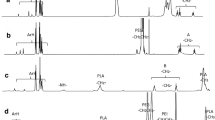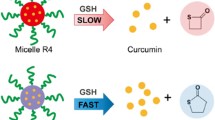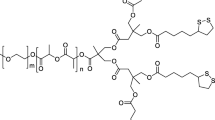Abstract
Purpose
The purpose of the study was to devise and evaluate crosslinked nanoassemblies to achieve enhanced drug delivery to tumors.
Methods
A novel copolymer comprised of polyethylene glycol 5000 (PEG114), Vitamin E (VE) and thioctic acid (TA) with a molar ratio of PEG114:VE:TA at 1:4:4 was synthesized. The resulting PEG114-VE4-TA4 copolymer self-assembled into micelles, which formed polydisulfide crosslinks catalyzed by dithiothreitol. Employing paclitaxel as a model drug, the crosslinked PEG114-VE4-TA4 micelles were characterized for the physicochemical and biological properties. The pharmacokinetics and anticancer efficacy of paclitaxel-loaded crosslinked PEG114-VE4-TA4 micelles were assessed in a human ovarian cancer xenograft murine model.
Results
The crosslinked PEG114-VE4-TA4 micelles demonstrated markedly improved thermodynamic and kinetic stability. The disulfide crosslinks were responsive to the intracellular level of glutathione, which caused rapid disassembly of the micelles and accelerated drug release. Intravenous administration of paclitaxel-loaded crosslinked PEG114-VE4-TA4 micelles yielded approximately 3-fold and 5-fold higher plasma concentration than the non-crosslinked micelles and Taxol®, respectively, leading to increased drug accumulation in the tumor. Importantly, paclitaxel-loaded crosslinked micelles exerted superior tumor growth repression compared to the non-crosslinked counterparts and Taxol®.
Conclusions
These results suggest that the crosslinked PEG114-VE4-TA4 nanocarrier system is a promising platform for the delivery of hydrophobic anticancer agents.












Similar content being viewed by others
Abbreviations
- B-CMs:
-
Blank crosslinked micelles
- B-NCMs:
-
Blank non-crosslinked micelles
- CMC:
-
Critical micelle concentration
- DiD:
-
1,10-dioctadecyl-3,3,30,30-tetramethylindodicarbocyanine perchlorate
- DiI:
-
1,1’-dioctadecyl-3,3,3’,3’-tetramethylindocarbocyanine perchlorate
- DiO:
-
3,3’-dioctadecyloxacarbocyanine perchlorate
- DLS:
-
Dynamic light scattering
- DP-CMs:
-
DiD/paclitaxel-dual loaded crosslinked micelles
- DP-NCMs:
-
DiD/paclitaxel-dual loaded non-crosslinked micelles
- DTT:
-
Dithiothreitol
- EPR:
-
Enhanced permeability and retention
- FRET:
-
Fluorescence energy transfer
- GSH:
-
Glutathione
- H&E:
-
Hematoxylin and eosin
- NIR:
-
Near Infrared
- P-CMs:
-
Paclitaxel-loaded crosslinked micelles
- PCNA:
-
Proliferating cell nuclear antigen
- P-NCMs:
-
Paclitaxel-loaded non-crosslinked micelles
- SDS:
-
Sodium dodecyl sulfate
- TA:
-
Thioctic acid
- TEM:
-
Transmission electron microscopy
- VE:
-
Vitamin E
References
Cheng Z, Zaki AAI, Hui JZ, Muzykantov VR, Tsourkas A. Multifunctional nanoparticles: cost versus benefit of adding targeting and imaging capabilities. Science. 2012;338(6109):903–10.
Kwon GS, Kataoka K. Block copolymer micelles as long-circulating drug vehicles. Adv Drug Deliv Rev. 2012;64:237–45.
Gong J, Chen M, Zheng Y, Wang S, Wang Y. Polymeric micelles drug delivery system in oncology. J Control Release. 2012;159(3):312–23.
Maeda H, Nakamura H, Fang J. The EPR effect for macromolecular drug delivery to solid tumors: improvement of tumor uptake, lowering of systemic toxicity, and distinct tumor imaging in vivo. Adv Drug Deliv Rev. 2013;65(1):71–9.
Owen SC, Chan DP, Shoichet MS. Polymeric micelle stability. Nano Today. 2012;7(1):53–65.
Chen H, Kim S, He W, Wang H, Low PS, Park K, et al. Fast release of lipophilic agents from circulating PEG-PDLLA micelles revealed by in vivo Förster resonance energy transfer imaging. Langmuir. 2008;24(10):5213–7.
O’Reilly RK, Hawker CJ, Wooley KL. Cross-linked block copolymer micelles: functional nanostructures of great potential and versatility. Chem Soc Rev. 2006;35(11):1068–83.
Read ES, Armes SP. Recent advances in shell cross-linked micelles. Chem Comm. 2007;29:3021–35.
van Nostrum CF. Covalently cross-linked amphiphilic block copolymer micelles. Soft Matter. 2011;7(7):3246–59.
Shao Y, Huang W, Shi C, Atkinson ST, Luo J. Reversibly crosslinked nanocarriers for on-demand drug delivery in cancer treatment. Ther Deliv. 2012;3(12):1409–27.
Li Y, Xiao K, Luo J, Xiao W, Lee JS, Gonik AM, et al. Well-defined, reversible disulfide cross-linked micelles for on-demand paclitaxel delivery. Biomaterials. 2011;32(27):6633–45.
Lee SY, Kim S, Tyler JY, Park K, Cheng JX. Blood-stable, tumor-adaptable disulfide bonded mPEG-(Cys)4-PDLLA micelles for chemotherapy. Biomaterials. 2013;34(2):552–61.
Koo AN, Min KH, Lee HJ, Lee SU, Kim K, Kwon IC, et al. Tumor accumulation and antitumor efficacy of docetaxel-loaded core-shell-corona micelles with shell-specific redox-responsive cross-links. Biomaterials. 2012;33(5):1489–99.
Wei R, Cheng L, Zheng M, Cheng R, Meng F, Deng C, et al. Reduction-responsive disassemblable core-cross-linked micelles based on poly(ethylene glycol)-b-poly(N-2-hydroxypropyl methacrylamide)-lipoic acid conjugates for triggered intracellular anticancer drug release. Biomacromolecules. 2012;13(8):2429–38.
Wu L, Zou Y, Deng C, Cheng R, Meng F, Zhong Z. Intracellular release of doxorubicin from core-crosslinked polypeptide micelles triggered by both pH and reduction conditions. Biomaterials. 2013;34(21):5262–72.
Schafer FQ, Buettner GR. Redox environment of the cell as viewed through the redox state of the glutathione disulfide/glutathione couple. Free Radic Biol Med. 2001;30(11):1191–212.
Kuppusamy P, Li H, Ilangovan G, Cardounel AJ, Zweier JL, Yamada K, et al. Noninvasive imaging of tumor redox status and its modification by tissue glutathione levels. Cancer Res. 2002;62(1):307–12.
Zhang Z, Tan S, Feng SS. Vitamin E TPGS as a molecular biomaterial for drug delivery. Biomaterials. 2012;33(19):4889–906.
Mu L, Elbayoumi TA, Torchilin VP. Mixed micelles made of poly(ethylene glycol)-phosphatidylethanolamine conjugate and D-α-tocopheryl polyethylene glycol 1000 succinate as pharmaceutical nanocarriers for camptothecin. Int J Pharm. 2005;306(1):142–9.
Chandran T, Katragadda U, Teng Q, Tan C. Design and evaluation of micellar nanocarriers for 17-allyamino-17-demethoxygeldanamycin (17-AAG). Int J Pharm. 2010;392(1):170–7.
Wang J, Sun J, Chen Q, Gao Y, Li L, Li H, et al. Star-shape copolymer of lysine-linked di-tocopherol polyethylene glycol 2000 succinate for doxorubicin delivery with reversal of multidrug resistance. Biomaterials. 2012;33(28):6877–88.
Lu J, Huang Y, Zhao W, Chen Y, Li J, Gao X, et al. Design and characterization of PEG-derivatized Vitamin E as a nanomicellar formulation for delivery of paclitaxel. Mol Pharm. 2013;10(8):2880–90.
Lawson KA, Anderson K, Menchaca M, Atkinson J, Sun L, Knight V, et al. Novel Vitamin E analogue decreases syngeneic mouse mammary tumor burden and reduces lung metastasis. Mol Cancer Ther. 2003;2(5):437–44.
Katragadda U, Fan W, Wang Y, Teng Q, Tan C. Combined delivery of paclitaxel and tanespimycin via micellar nanocarriers: pharmacokinetics, efficacy and metabolomic analysis. PLoS One. 2013;8(3):e58619.
Held KD, Melder DC. Toxicity of the sulfhydryl-containing radioprotector dithiothreitol. Radiat Res. 1987;112(3):544–54.
Carmack M, Kelley CJ, Harrison Jr SD. Optically active dithiothreitol. Toxicity and radiation-protective activity. J Med Chem. 1972;15(6):600–3.
Aguiar J, Carpena P, Molina-Bolivar JA, Ruiz CC. On the determination of the critical micelle concentration by the pyrene 1 : 3 ratio method. J Colloid Interface Sci. 2003;258(1):116–22.
Sadownik A, Stefely J, Regen SL. Polymerized liposomes formed under extremely mild conditions. J Am Chem Soc. 1986;108(24):7789–91.
Li YL, Zhu L, Liu Z, Cheng R, Meng F, Cui JH, et al. Reversibly stabilized multifunctional dextran nanoparticles efficiently deliver doxorubicin into the nuclei of cancer cells. Angew Chem Int Ed Engl. 2009;48(52):9914–8.
Kang N, Perron ME, Prud’homme RE, Zhang Y, Gaucher G, Leroux JC. Stereocomplex block copolymer micelles: core-shell nanostructures with enhanced stability. Nano Lett. 2005;5(2):315–9.
Bruce CD, Berkowitz ML, Perera L, Forbes MDE. Molecular dynamics simulation of sodium dodecyl sulfate micelle in water: micellar structural characteristics and counterion distribution. J Phys Chem B. 2002;106(15):3788–93.
Berney C, Danuser G. FRET or no FRET: a quantitative comparison. Biophys J. 2003;84(6):3992–4010.
Rejman J, Oberle V, Zuhorn IS, Hoekstra D. Size-dependent internalization of particles via the pathways of clathrin-and caveolae-mediated endocytosis. Biochem J. 2004;377(1):159–69.
Peng L, Liu RW, Marik J, Wang XB, Takada Y, Lam KS. Combinatorial chemistry identifies high-affinity peptidomimetics against α4β1 integrin for in vivo tumor imaging. Nat Chem Biol. 2006;2(7):381–9.
Kim SC, Kim DW, Shim YH, Bang JS, Oh HS, Kim SW, et al. In vivo evaluation of polymeric micellar paclitaxel formulation: toxicity and efficacy. J Control Release. 2001;72(1):191–202.
ACKNOWLEDGMENTS AND DISCLOSURES
This work was supported by the National Institutes of Health grant R15 CA152860 to C.T.
Wei Fan and Yingzhe Wang contributed equally to the work.
Author information
Authors and Affiliations
Corresponding author
Electronic supplementary material
Below is the link to the electronic supplementary material.
ESM 1
(DOCX 1519 kb)
Rights and permissions
About this article
Cite this article
Fan, W., Wang, Y., Dai, X. et al. Reduction-responsive Crosslinked Micellar Nanoassemblies for Tumor-targeted Drug Delivery. Pharm Res 32, 1325–1340 (2015). https://doi.org/10.1007/s11095-014-1537-6
Received:
Accepted:
Published:
Issue Date:
DOI: https://doi.org/10.1007/s11095-014-1537-6




